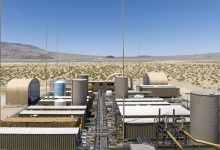President Nicolae Turdean Shares NAMR Priorities in 2021
Offshore Gas Exploitation and Resuming the Licensing Round for Offshore Blocks
President Klaus Iohannis enacted in late November 2020 the legal act amending and supplementing the Mining Law No. 85/2003. Part of the mining royalties due to the state budget will be transferred to local authorities on whose administrative territory the exploitation for which royalty has been collected is found. Also, the new law provides that by July 1, 2021, the Government will modify the organization and functioning structure of the National Agency for Mineral Resources (NAMR) to change its status from agency to national regulatory authority for mineral resources and petroleum. About the novelties to the Mining Law and NAMR priorities, we have talked with the President of the institution, Nicolae Turdean.
Mr. Turdean, what was the context in which the amendment to the Mining Law occurred?
Nicolae Turdean: First, we are talking about the amendment to a law adopted in 2003, which no longer meets the requirements. It was necessary to cut red tape of the regime of approval of exploitation licenses for building materials and mineral waters. According to the provisions of the old law, all licenses for the exploitation of building materials and mineral waters were approved by Government Decision. Therefore, an important amendment grants NAMR the right to approve by order the exploitation licenses for building materials, concluded during 1999-2019 and not yet approved by Government Decision. When I took over as NAMR President, in November 2019, there were 456 licenses for the exploitation of mineral resources that had not been promoted by Government Decision. Of these, 330 licenses are aimed at the exploitation of mineral resources that can be used in construction (metamorphic rocks, eruptive rocks, and sedimentary rocks of local importance). Licenses concluded during 1999-2019 having as subject matter other categories of mineral resources or licenses concluded after 2019, irrespective of the mineral resource aimed, are not covered by these legal provisions.
What will happen with licenses held by companies that go insolvent or bankrupt?
Nicolae Turdean: The new Mining Law is put in correlation with the Bankruptcy and Insolvency Law. I recall that the Mining Law appeared in 2003 and for this reason it made no reference to bankruptcy and insolvency. Therefore, the transfer of licenses from insolvent companies with license pending approval to viable companies was not possible. Now the problem has been solved.
Many mining perimeters have been closed. Will there be an attempt to reopen them?
Nicolae Turdean: Another novelty brought by the law refers to the exploitation of mining perimeters with suspended activity. There are over 550 such perimeters. The law now provides the possibility for resuming the mining activity in perimeters where such activity had been stopped under Government Decisions. The initiative of reopening the perimeters may belong to the Ministry of Economy and potential investors.
The royalty regime also changes. What is it about?
Nicolae Turdean: The new law provides that 35% of the mining royalty obtained from activities of exploitation of surface resources and carbonated or non-carbonated mineral waters represents revenue to the budget of local authorities on the territory of which the exploitation activity is carried out, 45% to the local budget of the commune, town, or city, on the territory of which the exploitation activity is carried out, and the rest of 20% will go to the state budget. This provision of the new law is extremely important for local authorities on the territory of which such exploitation takes place. They will have certain funds available to finance the priority investment projects for local communities. Also, they will have greater interest in collaboration with investors for the exploitation of local resources.
What was the value of royalties collected last year by the Romanian state from such exploitation?
Nicolae Turdean: Last year, the mining royalty obtained from the activities of exploitation of surface resources and carbonated or non-carbonated mineral waters was around RON 160mln. It should be mentioned however that this amount was collected by the state budget at a coefficient of capitalization on local resources of only 45%.
What can you tell us about the 11th Licensing Round for oil and gas blocks?
Nicolae Turdean: Tenders for granting licenses for new blocks, Round XI, are split into two, as following analyses carried out, we have found that the legal provisions of NAMR overlap with those on the safety of petroleum operations, coordinated by the Competent Regulatory Authority for Black Sea Offshore Petroleum Operations. Therefore, it has been decided to momentarily stop publication of the public invitation to tender in the Official Journal of the European Union. In the first stage tenders will be organized only for the concession of onshore blocks, and this will most likely happen early next year.
What will be NAMR’s priorities for 2021?
Nicolae Turdean: We are witnessing a real blockage of the exploitation activity, mainly due to the provisions of the current Mining Law. Updating it gives the possibility of restarting mining activities, with the following consequences:
- Unlocking the investments committed through licenses pending approval.
- Increasing revenues to the state budget.
- Creating new jobs etc.
In terms of organization, the priorities are the following:
- NAMR reorganization by separating the regulatory activities from the management of mineral resources; increasing the personnel and improving the remuneration system for employees.
- Reorganization of NAMR’s Regional Inspectorates and reconsideration of their territorial location.
- Continuing to strengthen the institutional collaboration with institutions with responsibilities in the fields adjacent to the activity of mineral resources.
A unitary approach of these directions of action generates the following consequences:
From an organizational and economic point of view:
- Updating the legislation on the identification and capitalization on mineral resources.
- Simplifying the procedures of approval/endorsement of documents for capitalization on mineral resources.
- Reducing bureaucracy in NAMR’s regulatory activity.
- Putting in place an efficient control mechanism to combat tax evasion in the field and monitoring how license and permit holders fulfil their obligations.
- Efficient management of geological data on knowledge and reorganization of the archiving and handling activities.
From a geo-strategic point of view:
- Developing the sector of critical materials identified in the RAW MATERIALS INITIATIVE (RMI) list by: identifying areas with useful mineral substance; establishing the strategy regarding their capitalization; putting into operation and superior capitalization of the materials included in the RMI list.
Restarting the exploitation activity and extending it in the former exploitation perimeters declared with closed activity by various license holders and in this case, titleholders proposing solutions of capitalization in the country of non-ferrous concentrates will be favoured. It is considered to restart mining activity in perimeters with suspended activity. The measure is addressed to the 556 perimeters with activity.
Also, another priority is to speed up the start of exploitation of natural gas from offshore blocks by amending the Offshore Law and resuming tenders for offshore blocks.







